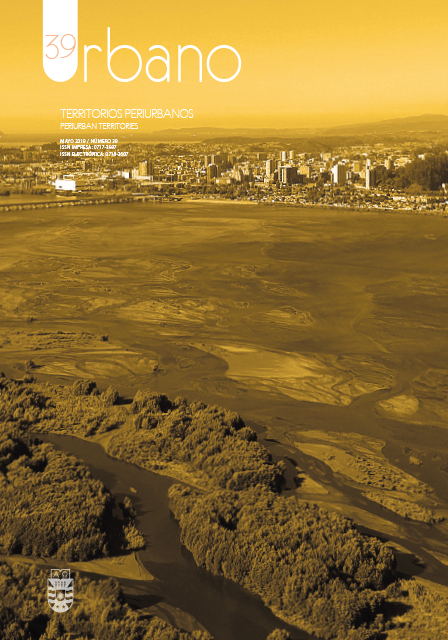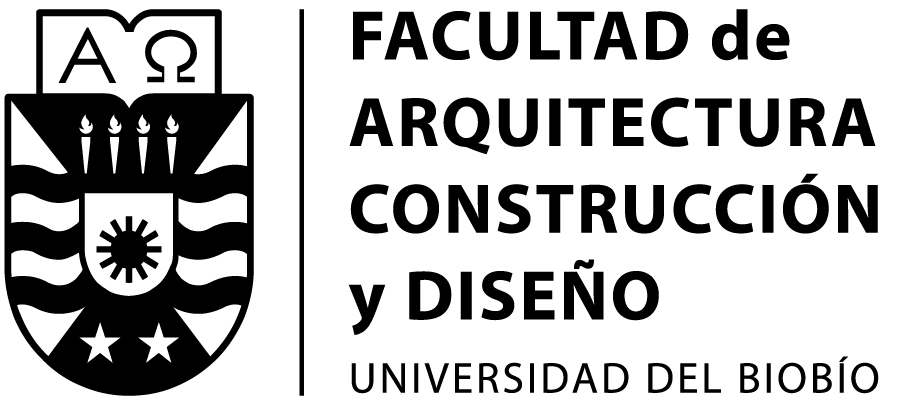Divergencias y contradicciones en la planificación sustentable del periurbano rural metropolitano de Valparaíso. Caso Reserva de la Biosfera La Campana-Peñuelas, Chile central/Divergences and contradictions in the sustainable planning of the...
DOI:
https://doi.org/10.22320/07183607.2019.22.39.04Palabras clave:
Planificación urbana, reserva natural, planificación ambiental, planificación regional, zona costeraResumen
La concentración de actividades humanas en territorios con urbanización intensa y carentes de planificación territorial, conduce a una alteración acumulativa de los procesos e interacciones en los ecosistemas naturales. Ante esto, se hace necesaria la adecuada planificación del crecimiento urbano en concordancia con el uso potencial y sustentable de los territorios. Esto es relevante en las regiones urbanas con valores ambientales naturales y patrimoniales, que eviten la degradación, la fragmentación espacial de lo agrícola y natural y la segregación socio-ambiental, entre otros. El objetivo del trabajo fue la identificación de las principales, divergencias, convergencias e incoherencias en materia de ordenamiento territorial, entre las normativas que regulan los usos del suelo asignados en los instrumentos de planificación territorial (IPTs) (Plan Regulador Intercomunal Satélite La Campana y PREMVAL) y los criterios de sustentabilidad que guían a las áreas naturales y patrimoniales propuestas en la Zonificación de la Reserva de la Biosfera la Campana –Peñuelas (RB), analizando la coherencia de la política urbanística y ambiental nacional. A través del estudio del Plan Regional Intercomunal Satélite La Campana y su contraste temático y cartográfico de la regulación espacial de los usos asignados, con el modelo de zonificación propuesto en la RB La Campana-Peñuelas, se analizaron los diferentes espacios de imbricación entre áreas de expansión y protección. Los resultados de las observaciones y recomendaciones en cada zona RB (núcleo, amortiguación y Transición), indican la coexistencia de zonas de conflictos territoriales, y en otras áreas de valor natural y agrícola. Se observa la inexistencia de una concordancia entre los IPTs que velen por la protección de las áreas de valor ambiental. La normativa presenta numerosas incoherencias y divergencias desajustadas de los criterios del desarrollo sustentable y de una figura de protección como una RB, particularmente en áreas asignadas con usos agrícolas. Se recomienda, actualizar las herramientas de participación y sensibilización ciudadana y modificar los criterios de sustentabilidad con los que son realizados los Instrumentos de Planificación Territorial.
Descargas
Citas
AGUILAR, Adrián y ESCAMILLA, Irma. Periferia urbana: deterioro ambiental y reestructuración metropolitana. Universidad Nacional Autónoma de México, Instituto de Geografía, 2009.
AGUILAR, Adrián; WARD, Peter y SMITH SR, C. B. Globalization, regional development, and mega-city expansion in Latin America: analyzing Mexico City’s peri-urban hinterland. Cities, 2003, vol. 20, n° 1, pp. 3-21.
ALLEN, Adriana. La interfase periurbana como escenario de cambio y acción hacia la sustentabilidad del desarrollo. Cuadernos del CENDES, 2003, vol. 20, n° 53, pp. 7-21.
ASCHER, François. Les nouveaux principes de l'urbanisme. La fin des villes n'est pas à l'ordre du jour. Editions de l'Aube, 2000.
ÁVILA, Héctor. Lo urbano-rural, ¿nuevas expresiones territoriales. Cuernavaca: UNAM. Centro regional de Investigaciones Multidisciplinarias, 2005.
BAILLY, Antoine y BOURDEAU-LEPAGE, Lise. Concilier désir de nature et préservation de l'environnement: vers une urbanisation durable en France. Géographie, économie, société, 2011, vol. 13, n° 1, pp. 27-43.
BAILLY, Antoine y SALAZAR, Alejandro. L’éclatement des métropoles chiliennes Zoom sur Santiago du Chili, Valparaíso et Concepción. Métropolitiques [en línea], 4 mars 2015. [Consultado 10 marzo 2019]. URL:http://www.metropolitiques.eu/L-eclatement-des-metropoles.html.CAPEL, Horacio. La morfología de las ciudades: Agentes urbanos y mercado inmobiliario. III. Ediciones del Serbal, 2013.
CATTANEO PINEDA, Rodrigo Andrés. Los fondos de inversión inmobiliaria y la producción privada de vivienda en Santiago de Chile: ¿Un nuevo paso hacia la financiarización de la ciudad? EURE (Santiago), 2011, vol. 37, n° 112, pp. 5-22.
COMISIÓN INTERMINISTERIAL CIUDAD, VIVIENDA Y TERRITORIO (COMICIVYT). Política Nacional de Ordenamiento Territorial 2018-2048, Santiago de Chile, 2018.
CONVENTION ON BIOLOGICAL DIVERSITY (CBD). Global Biodiversity Outlook 4. A mid-term assessment of progress towards the implementation of the Strategic Plan for Biodiversity 2011-2020. Montréal, 2014.
DE MATTOS, Carlos A. Una nueva geografía latinoamericana en el tránsito de la planificación a la gobernanza, del desarrollo al crecimiento. EURE (Santiago), 2010, vol. 36, n° 108, pp. 167-179.
GORENSTEIN, Silvia; NAPAL, Martín y OLEA, Mariana. Territorios agrarios y realidades rururbanas: Reflexiones sobre el desarrollo rural a partir del caso pampeano bonaerense. EURE (Santiago), 2007, vol. 33, n° 100, pp. 91-113.
HENRÍQUEZ, Cristian. El Sistema de Evaluación Ambiental bajo los Principios de la Carta Encíclica Laudato Si’. En: SALINAS, P. (ed.). La vía medioambiental. Desafíos y proyecciones para un Chile futuro. Santiago: Ministerio Medio Ambiente de Chile, 2018, pp. 263-272.
HIDALGO, Rodrigo; ALVARADO, Voltaire; VOLKER, Pascal; ARENAS, Federico y SALAZAR, Alejandro. Ordenamiento costero metropolitano en Chile: de la expectativa de regulación a la planificación cooptada (1965-2014). Cuadernos de Vivienda y Urbanismo [en línea], 2015, vol. 8, n° 16, pp. 206-225. DOI: https://doi.org/10.11144/Javeriana.cvu8-16.ocmc.
HIDALGO, Rodrigo; SALAZAR, Alejandro; LAZCANO, Rodrigo; ROA, Francisco; ÁLVAREZ, Lily y CALDERÓN, Mario. Transformaciones socio territoriales asociadas a proyectos residenciales de condominios en comunas de la periferia del Área Metropolitana de Santiago. Revista Invi, 2005, vol. 20 n° 54, pp.104–133.
HIDALGO, Rodrigo; SANTANA, Daniel; ALVARADO, Voltaire; ARENAS, Federico; SALAZAR, Alejandro; VALDEBENITO, Carlos y ÁLVAREZ, Luis. En las costas del neoliberalismo. Santiago Serie GEOlibros N° 23, Instituto de Geografía, Pontificia Universidad Católica de Chile -Instituto de Geografía, Pontificia Universidad Católica de Valparaíso, 2016.
JORQUERA GUAJARDO, Felipe; SALAZAR BURROWS, Alejandro; MONTOYA-TANGARIFE, Claudia. Nexos espacio-temporales entre la expansión de la urbanización y las áreas naturales protegidas. Un caso de estudio en la Región de Valparaíso, Chile. Investigaciones Geográficas [en línea], 2017, vol. 54, pp.41-60. DOI:10.5354/0719-5370.2017.48041.
KARG, Hanna; HOLOGA, Rafael; SCHLESINGER, Johannes; DRESCHER, Axel; KRANJAC-BERISAVLJEVIC, Gordana; GLASER, Ruediger. Classifying and Mapping Periurban Areas of Rapidly Growing Medium-Sized Sub-Saharan African Cities: A Multi-Method Approach Applied to Tamale, Ghana. Land, 2019, vol. 8 n°3, 40. DOI: 10.3390/land8030040
MARTIN, Vanier. Le pouvoir des territoires. Essai sur l’interterritorialité. Anthropos-Economica, 2° édition, 2010.
MARTÍN-LÓPEZ, Bertha; TORRES GONZÁLEZ, José; DÍAZ, Sandra; CASTRO, I. y GARCÍA-LLORENTE, M. Biodiversidad y bienestar humano: el papel de la diversidad funcional. Revista Ecosistemas, 2007, vol. 16, n° 3, pp. 69-80.
MEZA ALIAGA, Mónica; CASTRO CORREA, Carmen; PEREIRA ACUÑA, Karem y PUGA MORALES, Gustavo. Indicadores para el monitoreo de la calidad del suelo en áreas periurbanas. Valle de Quillota, cuenca del Aconcagua, Chile. Interciencia, 2017, vol. 42, n°8, pp. 494-502.
MILLWARD, Hugh. Peri‐urban residential development in the Halifax region 1960–2000: magnets, constraints, and planning policies. Canadian Geographer/Le Géographe canadien, 2002, vol. 46, n° 1, pp. 33-47.
MONTOYA-TANGARIFE, Claudia; DE LA BARRERA, Francisco; SALAZAR, Alejandro e INOSTROZA, Luis. Monitoring the effects of land cover change on the supply of ecosystem services in an urban region: A study of Santiago-Valparaíso, Chile. Plos One [en línea], 2017, vol. 12, n° 11, e0188117. DOI: https://doi.org/10.1371/journal.pone.0188117.
MOREIRA-MUÑOZ, Andrés y BORSDORF, Axel. Reservas de la Biosfera de Chile: Laboratorios para la sustentabilidad. Santiago de Chile: Academia de Ciencias Austriaca, Pontifica Universidad Católica de Chile, Instituto de Geografía, Santiago de Chile. Serie Geolibros, (17), 2014.
MOREIRA-MUÑOZ, Andrés; LEGUÍA, Marcelo y SABAINI, Carlo. Ambientes de montaña en transición: hacia un sistema sustentable de alimentación en la Región de Valparaíso, Chile. En: Innsbrucker Geographische Studien, Band 40: Die Welt verstehen – eine geographische Herausforderung. Eine Festschrift der Geographie Innsbruck für Axel Borsdorf, 2016. pp. 235–249.
MOREIRA-MUÑOZ, Andrés y SALAZAR, Alejandro. Reserva de la Biosfera La Campana-Peñuelas: micro-región modelo para la planificación del desarrollo regional sustentable. En: MOREIRA-MUÑOZ, Andrés y BORSDORF, Axel (eds.), Reservas de la Biosfera de Chile: Laboratorios para la sustentabilidad. Santiago: Serie GEOlibros (17). 2014, pp. 106-122.
NAVEZ-BOUCHANINE, Françoise. Les nouveaux territoires urbanisés: enjeu de société, défi aux métiers. En: NAVEZ-BOUCHANINE, Françoise (dir.). Intervenir dans les territoires à urbanisation diffuse. Paris: Ed. de L’Aube, 2005, pp. 9-36.
ORGANIZACIÓN DE LAS NACIONES UNIDAS (ONU). Habitat, Estado de las ciudades de América Latina y el Caribe. Rumbo a la nueva transición urbana. Río de Janeiro: ONU-Habitat, 2012.
PANEZ-PINTO, Alexander; MANSILLA, Pablo y MOREIRA-MUÑOZ, Andrés. Agua, tierra y fractura socio-metabólica del agronegocio: Actividad frutícola en Petorca, Chile. Bitácora Urbano Territorial, 2018, vol. 28, n° 3, pp. 156-160.
PAULSEN, Abraham; PETROVICH, Danilo y MOREIRA-MUÑOZ, Andrés. Popular Religion and Sustainability: Enhancing Synergies within a Biosphere Reserve. Eco.Mont, 2019, vol. 11, n° 2, pp. 52-56.
PROGRAMA DE LAS NACIONES UNIDAS PARA EL DESARROLLO (PNUD). Objetivos de Desarrollo Sostenible, Colombia Herramientas de aproximación al contexto local, 2016.
RAVETZ, Joe; FERTNER, Christian y NIELSEN, Tomas. The dynamics of peri-urbanization. En Peri-urban futures: Scenarios and models for land use change in Europe. Springer Berlin Heidelberg, 2013, pp. 13-44.
SALAZAR, Alejandro. Los espacios rurales periurbanos en la futura gestión metropolitana: Santiago de Chile. En: YAÑEZ, G.; ORELLANA, A.; FIGUEROA, O. y ARENAS F. (eds.). Ciudad, poder y gobernanza, EURE Libros y GEOlibros N°9. Instituto de Estudios Urbano y Territoriales. Instituto de Geografía. Pontificia Universidad Católica de Chile, Capítulo II, 2008, pp. 201-215.
SALAZAR, Alejandro. Recomposiciones socio-territoriales en los espacios peri-metropolitanos: ¿qué significados para las regiones urbanas en América Latina?: el caso de Santiago de Chile. En: BUZAI, G. y GARROCHO, C. (eds.), Geografía Aplicada en Iberoamérica: avances, retos y perspectivas, 2015, pp. 309-342.
SALAZAR, Alejandro; MOREIRA-MUÑOZ, Andrés y DEL RÍO, Camilo. La Campana-Peñuelas biosphere reserve in Central Chile: Threats and challenges in a peri-urban transition zone. Eco. Mont-Journal on Protected Mountain Areas Research [en línea], 2015, vol. 7, n° 1, pp. 66–71. DOI: https://doi.org/10.1553/eco.mont-7-1s66
SCHULZ, Jennifer; CAYUELA, Luis; ECHEVERRIA, Cristian; SALAS, Javier y REY, José. Monitoring land cover change of the dryland forest landscape of Central Chile (1975–2008). Applied Geography, 2010, vol. 30, n° 3, pp. 436-447.
SEPÚLVEDA, Sergio; RODRÍGUEZ Adrián y ECHEVERRI Rafael. Territorios rurales, estrategias y políticas en América Latina. Fortaleza, Brasil: Instituto Interamericano de Cooperación para la Agricultura (iica), 2013.
SERRA, Miguel; PINHO, Paulo. Dynamics of periurban spatial structures: investigating differentiated patterns of change on Oporto's urban fringe. 2011. Environment and Planning B-Planning & Design, 2011, vol. 38, n° 2, pp. 359-382. DOI: 10.1068/b36092
UNESCO. The Seville Strategy for Biosphere Reserves and The Statutory Framework of the World Network of Biosphere Reserves, UNESCO, Paris, 2005.
WORLD BANK. Beyond the City. The Rural Contribution to Development. Chapter 1 and 2, How Do We Define the Rural Sector. Washington, DC. 2005.WORLD BANK. Informe sobre el Desarrollo Mundial 2009: Una nueva Geografia económica. Banco Mundial. Washington, D.C. EE.UU., 2009.
Descargas
Publicado
Cómo citar
Número
Sección
Licencia
El contenido de los artículos y reseñas que se publican en cada número de Urbano, es responsabilidad exclusiva de los autores y no representan necesariamente el pensamiento ni comprometen la opinión de la Universidad del Bío-Bío.
Las/os autoras/es conservarán sus derechos de autor, sin embargo, garantizarán a la revista el derecho de primera publicación y difusión de su obra. La publicación del artículo en Urbano estará sujeta a la Licencia de Reconocimiento de Creative Commons CC BY-SA que permite a otros compartir-copiar, transformar o crear nuevo material a partir de esta obra para cualquier propósito, incluso comercialmente, siempre y cuando se reconozcan la autoría y la primera publicación en esta revista, y sus nuevas creaciones estén bajo una licencia con los mismos términos.![]()























